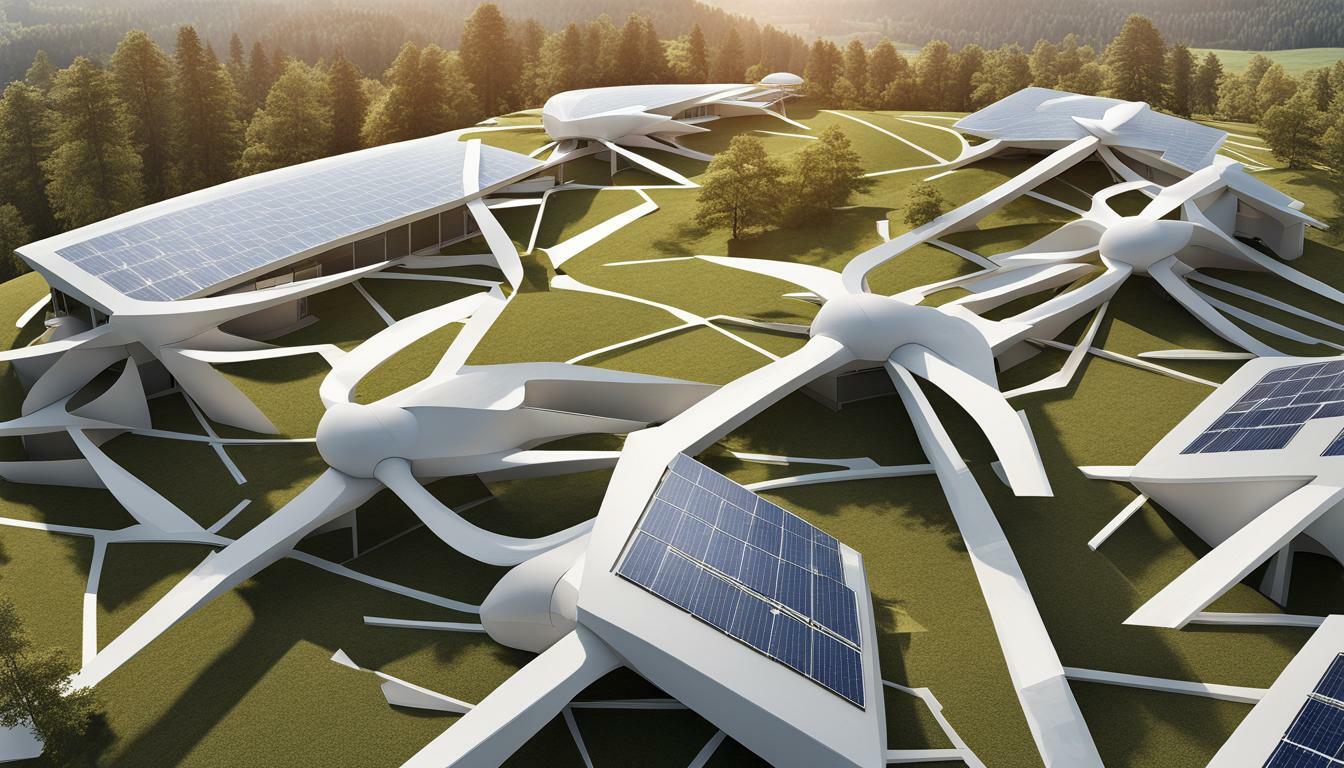Canada Green Building History
- Jackie De Burca
- April 8, 2024
Canada Green Building History
In recent years, there has been a growing focus on sustainable construction practices, environmentally-friendly architecture, and sustainable development in Canada. However, the roots of this movement can be traced back several decades, to when the country first began experimenting with green building concepts.
Canada Green Building History: A Rich Tapestry
Canada’s green building history is a rich tapestry of innovation, experimentation, and evolution. From the earliest low-tech solutions to the cutting-edge designs of today, the country has played a significant role in shaping the global green building movement.
Throughout this section, we will explore the fascinating history of green building in Canada, from its humble beginnings to the present day. We will discuss how sustainable construction practices have evolved over time, the impact they have had on the environment and the economy, and the challenges that still need to be addressed.
- Canada has a rich history in sustainable construction practices and environmentally-friendly architecture.
- The green building movement has gained significant momentum in recent years, with the adoption of energy-efficient buildings and eco-friendly construction methods.
- LEED certification has played a crucial role in shaping sustainable construction practices and promoting eco-friendly buildings.
- Sustainable development practices have contributed to reducing energy consumption, minimizing waste, and creating a more sustainable future in Canada.
- Despite the progress made, there are still challenges that need to be addressed in implementing sustainable construction practices and promoting environmentally-friendly architecture in the country.
The Green Building Movement Takes Root in Canada
As awareness grew about the impact of the construction industry on the environment, a new movement began to take shape in Canada. The green building movement emerged as a response to the need for more sustainable construction practices.
The movement gained momentum in the early 2000s, with more and more companies and individuals embracing eco-friendly construction methods. Energy-efficient buildings in Canada became a priority, with a focus on reducing energy consumption and minimizing waste.
Builders started incorporating sustainable materials in their designs, and eco-friendly construction practices became more commonplace. This led to the development of new technologies and techniques that helped to reduce the carbon footprint of new buildings.

Today, energy-efficient buildings in Canada are becoming increasingly common. From multi-story commercial buildings to small residential houses, builders are incorporating eco-friendly features such as solar panels, green roofs, and geothermal heating systems. These features not only reduce the environmental impact of the building but can also help to save money on energy bills.
The green building movement has also had a significant impact on the economy, creating new jobs in sectors such as renewable energy and sustainable materials. As more companies adopt green building practices, there is a growing demand for skilled workers in these areas.
The adoption of eco-friendly construction methods in Canada has been a major step towards a more sustainable future. Through continued innovation and dedication to sustainable practices, the country can continue to lead the way in the green building movement.
Sustainable Architecture in Canada: Pioneering Designs
Canada has made significant strides in sustainable architecture, with pioneering designs that prioritize environmentally-conscious practices. These innovative and sustainable designs have helped to shape the industry and promote sustainable development across the country.
One notable example is the Manitoba Hydro Place in Winnipeg, Manitoba. This impressive building was the first in North America to receive the LEED Platinum certification for its sustainable features. The unique design includes a soaring glass atrium, which allows for natural light to flood the building, reducing the need for artificial lighting and promoting energy efficiency. It also features a green roof, which helps to reduce stormwater runoff and regulate temperature.
The Dockside Green development in Victoria, British Columbia, is another excellent example of sustainable architecture in Canada. The mixed-use development includes residential, commercial, and retail spaces and has been designed to minimize its environmental impact through green building practices. It features a district energy system, rainwater harvesting, and a constructed wetland for wastewater treatment.
Other notable examples of sustainable architecture in Canada include the Centre for Interactive Research on Sustainability (CIRS) at the University of British Columbia, which features a living roof and uses natural ventilation and geothermal energy to reduce energy consumption, and the Evergreen Brick Works in Toronto, which repurposed a former industrial site and transformed it into a sustainable community space featuring green roofs, geothermal heating and cooling, and a stormwater management system.

These pioneering designs demonstrate the potential for sustainable architecture to transform the industry and promote a more sustainable future in Canada.
LEED Certification: Setting the Standard for Sustainable Buildings
LEED (Leadership in Energy and Environmental Design) certification is an internationally recognized standard for sustainable building design, construction, and operation. In Canada, LEED certification has played a significant role in shaping sustainable construction practices and promoting eco-friendly buildings.
LEED certification is based on a point system that evaluates buildings across several categories, including sustainable site development, water efficiency, energy and atmosphere, materials and resources, indoor environmental quality, and innovations in design. Buildings can achieve different levels of certification, ranging from Certified to Silver, Gold, and Platinum, depending on the number of points achieved.
| LEED Certification Levels | Points Required |
|---|---|
| Certified | 40-49 |
| Silver | 50-59 |
| Gold | 60-79 |
| Platinum | 80+ |
LEED certification has helped to drive innovation in sustainable building design and construction. Many of the notable examples of sustainable architecture in Canada, such as the Manitoba Hydro Place in Winnipeg and the VanDusen Botanical Garden Visitor Centre in Vancouver, have achieved LEED Platinum certification.
LEED certification also has a significant impact on the economy. According to a study by the Canada Green Building Council, LEED buildings in Canada generate $1.31 billion in GDP and create over 14,000 jobs each year. These buildings also save over 170 million kWh of electricity and reduce CO2 emissions by over 100,000 tonnes annually.

LEED certification has become an essential standard for sustainable buildings in Canada. As the industry continues to prioritize sustainability, LEED certification will continue to play a significant role in shaping sustainable construction practices and promoting environmentally-friendly architecture in the country.
The Impact of Green Building on the Environment and Economy
The implementation of sustainable development practices in the construction industry has been crucial in reducing energy consumption and minimizing waste in Canada. Through the adoption of green building practices, the industry has created a more sustainable future for generations to come.
The impact of green building goes beyond environmental benefits. It has also contributed significantly to the economy, creating new jobs and boosting economic growth. According to a report by the Canada Green Building Council, the green building sector contributed over $23.45 billion to the Canadian economy and supported over 300,000 full-time jobs in 2018 alone.
Furthermore, sustainable practices have also led to improved health and well-being for building occupants. Buildings designed with energy-efficient technologies and materials have been shown to reduce indoor air pollution and improve indoor comfort levels, resulting in better overall health.

However, despite the evident benefits of green building, there are still challenges to overcome. One of the main obstacles is the higher upfront cost of green building materials and technologies. This has caused some developers to prioritize short-term financial gain over long-term sustainability.
As we move towards a more sustainable future, it is important to continue educating and advocating for the benefits of green building. Additionally, the industry must invest in research and development to drive down the cost of sustainable materials and technologies, making them more accessible and affordable to all.
Key Challenges and Future Trends in Green Building
While sustainable construction practices and environmentally-friendly architecture have come a long way in Canada, there are still several key challenges that must be addressed to ensure continued progress. One of the most significant challenges is the cost of implementing green building practices. Despite the potential long-term savings in energy and maintenance costs, the initial investment required for sustainable materials and technologies can be prohibitively expensive for many builders and developers.
Another key challenge is the lack of knowledge and expertise in sustainable building practices among professionals in the construction industry. To promote widespread adoption of green building practices, it is crucial that builders, architects, engineers, and other professionals receive the training and education necessary to effectively implement sustainable development practices.
Looking to the future, there are several exciting trends and advancements in green building that are anticipated to shape the industry. One of the most exciting developments is the use of smart building technologies, which allow for real-time monitoring of energy usage and other environmental factors to optimize building performance.
Another important trend is the integration of renewable energy sources into building design. This includes the use of solar panels, wind turbines, and other forms of renewable energy to power buildings and reduce reliance on non-renewable energy sources. Additionally, there is a growing focus on the use of sustainable materials, such as bamboo and recycled materials, to reduce waste and minimize the environmental impact of construction.
It is clear that the future of green building in Canada is bright, with new innovations and advancements on the horizon. By addressing key challenges and embracing new trends and technologies, we can continue to build a more sustainable future for generations to come.

Canada’s green building history has been marked by a commitment to sustainable architecture and development. From the early days of eco-friendly construction methods to the pioneering designs of energy-efficient buildings, Canada has made significant strides in promoting environmentally-conscious practices.
The establishment of LEED certification in the country has set the standard for sustainable buildings and promoted the adoption of sustainable construction practices. This internationally recognized standard has played a significant role in shaping the industry towards eco-friendly buildings.
The wider impact of green building on the environment and the economy cannot be overlooked. Sustainable development practices have contributed to reducing energy consumption, minimizing waste, and creating a more sustainable future for Canada.
Building on Canada’s Green Building History for a Sustainable Future
As we look to the future, it is crucial to continue building on Canada’s green building history and embrace innovative solutions that prioritize sustainability. The key challenges of implementing sustainable construction practices and promoting environmentally-friendly architecture must be addressed, and future trends and advancements in green building must be anticipated and embraced.
Continued commitment to sustainable architecture and development is essential for a greener future for Canada. By prioritizing sustainability, we can create a more environmentally-conscious society that benefits both the environment and the economy.
Canada Green Building History FAQs
What is the history of green building in Canada?
The history of green building in Canada is rooted in the growing awareness of the need for sustainable construction practices. It dates back to the late 20th century when environmental concerns and the desire for energy-efficient buildings began to gain traction.
How has the green building movement evolved in Canada?
The green building movement in Canada has experienced significant growth over the years. It has seen the widespread adoption of energy-efficient buildings and the implementation of eco-friendly construction methods to reduce environmental impact and promote sustainability.
What are some notable examples of sustainable architecture in Canada?
Canada is home to several pioneering designs in sustainable architecture. Notable examples include the Manitoba Hydro Place in Winnipeg, the VanDusen Botanical Garden Visitor Centre in Vancouver, and the Okanagan College Centre for Learning in Kelowna.
What is the significance of LEED certification in Canada?
LEED (Leadership in Energy and Environmental Design) certification has played a crucial role in promoting sustainable construction practices in Canada. It sets the standard for eco-friendly buildings and encourages the adoption of energy-efficient systems, materials, and designs.
How does green building impact the environment and economy in Canada?
Green building practices in Canada have had a positive impact on both the environment and the economy. They have contributed to reducing energy consumption, minimizing waste, and creating a more sustainable future. Furthermore, they have created new jobs and stimulated economic growth in the green building sector.
What are the key challenges and future trends in green building in Canada?
Implementing sustainable construction practices and promoting environmentally-friendly architecture in Canada faces various challenges, such as cost implications and resistance to change. However, future trends indicate a greater focus on renewable energy, smart technologies, and the integration of nature in building designs.
What is the significance of Canada’s green building history?
Canada’s green building history has paved the way for sustainable architecture and development in the country. It has created a foundation for promoting eco-friendly practices and serves as a reminder of the importance of prioritizing sustainability for the benefit of both the environment and the economy.








